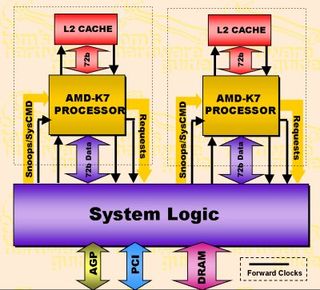The New Athlon Processor: AMD Is Finally Overtaking Intel
Athlon's EV6 Bus
One of the most important things to consider when talking about Athlon is its bus. Although Athlon's connector may look like Intel's Slot1-connector at the first look, those two CPUs are NOT compatible! AMD's 'SlotA' uses a completely different bus protocol, based on the DEC Alpha protocol 'EV6'. Many people thought that this different protocol would be a problem for Athlon and its acceptance on the market, but it seems as if the opposite is the case.

First of all I'd like to note that the EV6 or as AMD calls it Athlon front side bus is running at 100 MHz. Well, that sounds pathetic, doesn't it? However, the bus takes advantage of the rising as well as the falling edge of the bus clock for transfers, so that the technical 'speed' is 200 MHz. Thus EV6 and so Athlon's bus is currently the fastest system bus in x86-systems, transferring data at up to 1.6 GB/s. This is quite a bit more than the 1.06 GB/s that Pentium III will reach once 'Camino' or 'i820' is out and it's exactly double the bandwidth of current BX-systems. AMD says that EV6 is scalable up to 200 MHz = 400 MHz effective speed = 3.2 GB/s peak bandwidth and before this speed is reached there'll be 133 MHz = 266 MHz effective speed = 2.1 GB/s peak bandwidth. From this point of view it's obvious, EV6 is more than future proof and certainly superior to the P6-bus. But that's not all. Another beauty of this bus is the fact that in multi-processor environments each processor has its dedicated path to the chipset, because EV6 is a point-to-point connection of CPU and system. The P6-bus is a shared bus. This means that all processors have to share its bandwidth, leaving less for each processor, the more processors are used. EV6 offers the full bandwidth to each processor and it supports up to 14 processors in SMP-environments. The address space of EV6 is also higher than that of the P6-bus, it's 43 bit deep vs. 36-bit address depth of P6.
Stay on the Cutting Edge
Join the experts who read Tom's Hardware for the inside track on enthusiast PC tech news — and have for over 25 years. We'll send breaking news and in-depth reviews of CPUs, GPUs, AI, maker hardware and more straight to your inbox.
Most Popular

